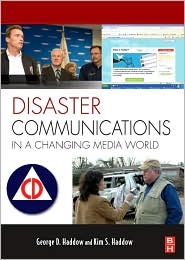Below are the results of the blog’s latest book contest  for Disaster Communications In A Changing Media World (Butterworth-Heinemann) by George D. Haddow and Kim S. Haddow. Entrants were asked to write “what you think is the most useful new communications application for citizens to use for disaster preparation/response.“ The winners (and their entries) are:
Giovanni Taylor-Peace/Atlanta, Georgia –Â “My vote is for YouTube as the most useful new communications application for citizens to use for disaster preparation/response.”
Grant Olsen/Boone, Iowa –Â “I think the most useful new communications application for citizens to use for disaster response is the text-message-based system Twitter. It allows citizens to send a personal status message (for example, “I’m OK”) to multiple friends and family with just one text message. It also allows people to subscribe to real-time information from government agencies and relief agencies (for example, “Shelter opened at middle school.”) that use Twitter. Compared to cell phone voice calls, text messages lessen the burden on the cell phone network infrastructure.”
Grant Gordon/Chicago, Illinois –Â “Working in the field – primarily in the Eastern DRC – I would have to say text messaging is really going to change how we communicate in disasters. As soon as we create an on the ground network SMS responses it will multidirectional coordination: laterally between responders, bottom-to-top from people experiencing the disaster to responders, and top-to-bottom from responders to those experiencing the disaster. The next step is incorporating SMS into logistics and figuring out how we can direct and redirect population movement to make supply-chains more effective. Now, if only we had better coverage in the DRC….”
Lloyd Colston/Altus, Oklahoma –Â “Twitter holds the most promise for the citizen to be involved in emergencies. The ability of Twitter to get the word to Government officials is important. Some government agencies already report hearing items from Twitter.”
James Garrow/Philadelphia, Pennsylvania – “As far as what new communications application is the most useful for use in disaster preparation and response, I’m kind of going to cheat. To me, the most useful tool is the cell phone; every type of cell phone from the old Nokia brick we all had back in the day to a sleek iPhone. Each and any of these phones connects us to the grid. We are now able to be contacted anywhere, or to contact others anywhere. The problem for emergency communicators isn’t developing messages or disseminating messages–it’s ensuring that people receive the messages. If I put a life-saving message on TV, but no one is watching TV, it’s a wasted message. But if I get the appropriate message to someone who needs it when they need it, that message is the most valuable thing in the world (and it doesn’t matter if it’s a browser message, an email, a text message or a reverse 911 message).  While tools like this are developed all of the time, the thing that makes cell phones different is their acceptance, their ubiquity. How many people do you know that don’t have a cell phone? On a crowded corner downtown, how many people don’t have a cell phone? Access and availability, that’s all that’s needed for a successful emergency communication.





4 responses so far ↓
1 Richard // May 7, 2009 at 9:52 pm
I agree that Youtube, Twitter and Text Messaging are valuable tools for given groups. I am not one of those groups. I will be using TV. I am disapponted that I have not yet found a battery powered digidal TV. ROH
2 Lorrie // May 8, 2009 at 10:07 am
I have to vote for the cell phone as well. Athough Twitter, Youtube, etc. may be growing daily, I find it tends to be more the younger generation who are getting on the bandwagon there. Pretty well everyone knows how to use and has access to a cell phone.
3 Emergency Messaging // May 9, 2009 at 7:38 am
Facebook is really good and is available for personel private talk also. Thank you
4 admin // May 9, 2009 at 7:45 am
Yes, even as new technology is being increasingly used, a lot of people will still rely on ‘traditional’ ways of communications during an emergency. The key I think is to use a range of methods.
-John
Leave a Comment